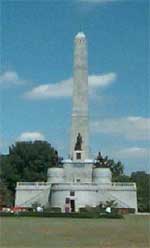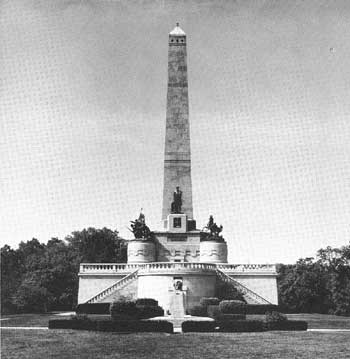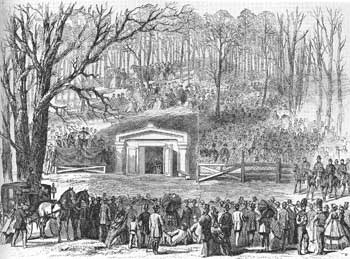






Survey of
Historic Sites and Buildings
 |
Lincoln Tomb Illinois |
 Lincoln Tomb |
| ||
This impressive memorial—a showplace of Lincoln statuary and symbolic ornamentation—contains his tomb as well as those of his wife and three of their four sons.
On April 15, 1865, the day after President Lincoln's assassination, a group of Springfield citizens, learning that the body would be returned to Illinois for burial, formed the National Lincoln Monument Association and spearheaded a drive for funds to construct a memorial/tomb. Upon arrival of the corpse on May 3, it lay in state in the capitol for a night, and after the funeral the next day was placed in a receiving vault at Oak Ridge Cemetery, the site Mrs. Lincoln had requested for burial. In December her husband's remains were removed to a temporary vault not far from the proposed memorial site. In 1871, or 3 years after laborers had begun constructing the tomb, the body of Lincoln and those of the three youngest of his sons were placed in crypts in the unfinished structure.
 |
| Lincoln Tomb. (National Park Service, Dave Beatty Studios, 1976.) |
In 1874, upon completion of the memorial, Lincoln's remains were interred in a marble sarcophagus in the center of a chamber known as the "catacombs," or burial room. In 1876, however, after two Chicago criminals failed in an attempt to steal Lincoln's body and hold it for ransom, the National Lincoln Monument Association hid it in another part of the memorial. When Mrs. Lincoln died in 1882, her remains were placed with those of Lincoln, but in 1887 both bodies were reburied in a brick vault beneath the floor of the burial room.
By 1895, the year the State acquired the memorial, it had fallen into disrepair. During a rebuilding and restoration program in 1899-1901, all five caskets were moved to a nearby subterranean vault. In the latter year, State officials returned them to the burial room and placed that of Lincoln in the sarcophagus it had occupied in 1874-76. Within a few months, however, at the request of Robert Todd Lincoln, the President's only surviving son, the body was moved to its final resting place, a cement vault 10 feet below the surface of the burial room. In 1930-31 the State reconstructed the interior of the memorial. Rededicated in the latter year by President Hoover, it has undergone little change since that time.
The tomb is in the center of a 12-1/2-acre plot. Constructed of Massachusetts granite, it has a rectangular base surmounted by a 117-foot-high obelisk and a semicircular entrance way. A bronze reproduction of sculptor Gutzon Borglum's head of Lincoln in the U.S. Capitol rests on a pedestal in front of the entrance way. Four flights of balustraded stairs—two flanking the entrance at the front and two at the rear—lead to a level terrace. The balustrade extends around the terrace to form a parapet.
In the center of the terrace, a large and ornate base supports the obelisk. On the walls of the base are 37 ashlars, or hewn stones, cut to represent raised shields, each engraved with the name of a State at the time the tomb was built. Each shield is connected to another by two raised bands, and thus the group forms an unbroken chain encircling the base. Four bronze statues adorn the corners of the latter. They represent the infantry, navy, artillery, and cavalry of the Civil War period. In front of the obelisk and above the entrance stands a full-length statue of Lincoln.
 |
| Ceremony during Lincoln's initial burial in a temporary tomb. (Engraving, after a sketch by Thomas Hogan, in Frank Leslie's Illustrated Newspaper, May 27, 1865, Library of Congress.) |
The interior of the memorial, constructed of marble from Minnesota, Missouri, Massachusetts, Arkansas, Utah, Italy, Spain, France, and Belgium, contains a rotunda, burial room, and connecting corridors. A replica of the Daniel C. French statue in the Lincoln Memorial, in Washington, D.C., dominates the entrance foyer. The walls of the rotunda are decorated with 16 marble pilasters, which are separated by marble panels. The pilasters symbolize Lincoln and the 15 Presidents who preceded him. The room also contains 36 bronze panels, one for each State at the time of Lincoln's death. The ceiling is of platinum leaf.
Corridors lead from the rotunda to the burial room at the rear of the memorial. Located in niches along the corridor walls are eight statues by prominent sculptors depicting various phases of Lincoln's life. Four bronze tablets on the walls are engraved with the Farewell Address, the Gettysburg Address, a portion of the Second Inaugural Address, and a biographical sketch. Large gold stars in sets of 12 at each corner of the memorial represent the 48 States in the Union at the time of its remodeling.
The burial room features black and white marble walls and a ceiling of gold leaf. At its center stands the cenotaph, a 7-ton block of reddish marble inscribed with Lincoln's name and the years he lived. It marks the approximate location of the burial vault. Nine flags are arranged in a semicircle around the cenotaph. Seven of them—the State flags of Massachusetts, New Jersey, Pennsylvania, Virginia, Kentucky, Indiana, and Illinois—commemorate the homes of Lincoln and his ancestors. The eighth and ninth are the Stars and Stripes and the Presidential flag. The inscription "Now he belongs to the ages," reputedly spoken by Secretary of War Edwin M. Stanton at the time of Lincoln's death, is inscribed in the wall above the U.S. Flag. Along the south wall of the burial room are five crypts containing the remains of Mrs. Lincoln, three of Lincoln's four sons, and a grandson.
The Lincoln tomb is owned and administered by the State of Illinois.
 |
 |
http://www.cr.nps.gov/history/online_books/presidents/site19.htm
Last Updated: 22-Jan-2004